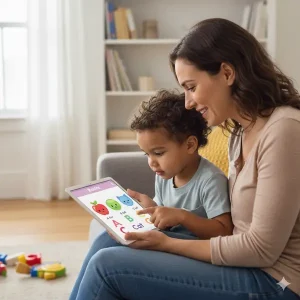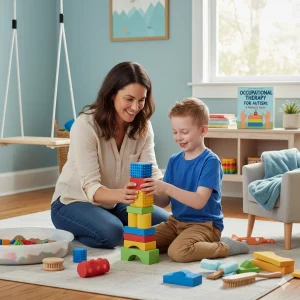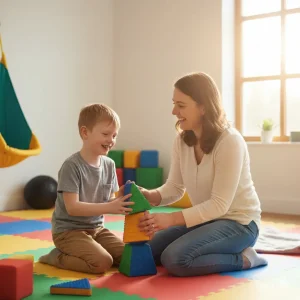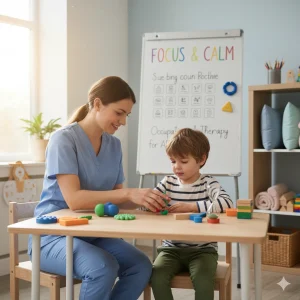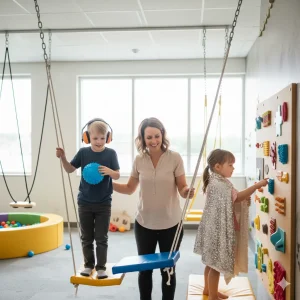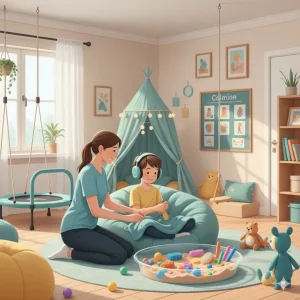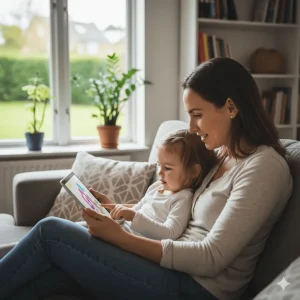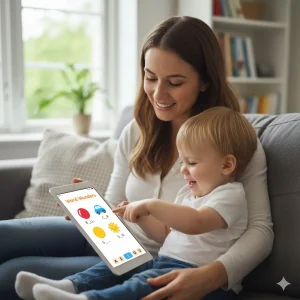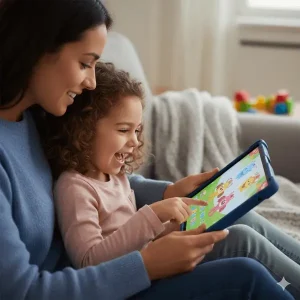Inside the BASICS App: A Parent’s Guide to How It All Works
By Wellness Hub
Last Updated: October 15, 2025
If you’ve ever wondered how your child can learn speech, language, and thinking skills through play—you’re not alone. Many parents want to make screen time meaningful but don’t know where to start. That’s exactly why the BASICS App was created — to turn everyday screen moments into opportunities for learning, communication, and connection.
Designed by a team of speech and occupational therapists, the BASICS App simplifies early development into fun, structured activities your child will love. From matching and memory games to sentence-building and question-answering, every task has a purpose — to help your child listen, speak, and think with growing confidence.
Whether your child is just starting to name objects, forming first sentences, or exploring emotions, BASICS guides you step by step through each milestone. In this parent’s guide, we’ll walk you through exactly how the app works — its levels, goals, and learning modes — so you can use it effectively at home and see real progress unfold.
What is the BASICS App and Who Is It For?
The BASICS App is a therapist-designed speech and early learning app for kids that helps children build essential communication, social, and cognitive skills through play-based, structured activities. Created by speech-language pathologists, occupational therapists, and child development experts, BASICS transforms everyday screen time into purposeful learning for children aged 2 to 8 years.
At its core, BASICS App focuses on speech, language, attention, and emotional growth, using interactive visuals, sounds, and games that are carefully sequenced to match a child’s developmental stage. Each level—from matching and memory games to sentence building and emotional expression—is crafted to make learning engaging, effective, and age-appropriate.
BASICS is especially helpful for children with speech delay, autism, ADHD, or other developmental differences, offering a calm, structured environment where learning happens through repetition and positive feedback. The app’s design supports neurodiverse learners by providing visual clarity, predictable routines, and sensory-friendly interactions that encourage focus and confidence.
For parents, BASICS App acts as a guided tool to reinforce therapy goals at home, even without professional supervision. Therapists use it to complement online or in-person sessions, track progress, and assign follow-up practice.
In short, BASICS bridges the gap between therapy and home learning—making it the most versatile speech therapy app for kids, an adaptive autism app for communication, and a comprehensive early learning app for preschool readiness and developmental growth.
How the BASICS App is Structured – Levels, Goals, and Progression
The BASICS App follows a carefully designed, therapist-crafted structure that mirrors how children naturally develop speech, cognition, and social understanding. Every level builds on the one before it, ensuring that your child learns at their own pace—from simple recognition tasks to expressive communication and early academics.
This structured approach combines 10 developmental levels and 24 therapy-aligned goals, giving parents and therapists a clear roadmap for growth. The design ensures that play never feels random—it follows an evidence-based sequence backed by child development science.
10 Developmental Levels for BASICS App
Each BASICS level focuses on a distinct area of child development, gradually expanding language, thinking, and social-emotional skills. Together, they create a complete pathway for children aged 2 to 8 years.
| Level | Name | Skill Focus | Key Highlights |
|---|---|---|---|
| 1 | Foundation Forest | Early learning and cognitive skills | Matching, sounds, memory, colors, shapes, pre-math |
| 2 | Articulation Adventures | Speech clarity and sound practice | Fun articulation games for /R/, /S/, /L/, and more |
| 3 | Word Wonders | Vocabulary and word learning | Video modeling for first words (animals, food, actions) |
| 4 | Vocabulary Valley | Object identification and naming | Tap, match, and name familiar items |
| 5 | Phrase Park | Combining words into phrases | 2–3 word speech development through play |
| 6 | Spelling Safari | Early literacy and spelling | Linking sound to letters and spelling patterns |
| 7 | Inquiry Island | Question-answering and reasoning | WH questions (What, Where, Who, When, Why, How) |
| 8 | Conversation Circles | Social communication and conversations | Turn-taking, emotions, sharing, greetings |
| 9 | Sentence Symphony | Sentence formation and grammar | He/She sentences, plurals, comparatives, sentence structure |
| 10 | Math Magic | Early numeracy and logical reasoning | Counting, addition, subtraction (objects to numbers) |
Progression Overview:
Children begin in Foundation Forest, exploring sensory and matching games that build focus and recognition. As they progress, levels introduce vocabulary expansion, sentence building, social communication, and finally, academic readiness through Math Magic.
Each level is unlocked after mastering simpler ones—offering both a sense of achievement and consistent developmental growth.
Therapist-Crafted Goals
Every goal within the BASICS App is designed by a team of speech-language pathologists, occupational therapists, and early-childhood educators. These goals address real-world developmental milestones—ensuring that learning inside the app supports growth outside it.
Some examples include:
- Early Learning Skills: Builds focus, matching, and memory for toddlers (ages 2–3).
- Core Language Skills: Expands vocabulary and introduces two-word phrases (ages 3–4).
- Emotions Explorer: Teaches children to recognize and name feelings through visuals and storytelling.
- Understanding WH Questions: Develops comprehension and reasoning through interactive Q&A.
- Pre-Math Concepts: Introduces comparison, size, and counting in a play-based format.
Each goal aligns with an evidence-based therapy framework, following a gradual progression from recognition → understanding → expression → reasoning. This structured pathway ensures measurable improvement while keeping the experience engaging and child-friendly.
Age-Appropriate Activities
BASICS adapts activities to match your child’s age, stage, and skill readiness—so learning always feels achievable and fun.
Here’s how development unfolds across the early years:
- Ages 2–3: Children explore matching, sounds, and simple memory games. These activities improve attention, imitation, and first words.
Example: Matching fruits, tapping colors, or identifying body parts. - Ages 3–4: Language blossoms. Kids start naming objects, understanding yes/no and WH questions, and describing actions.
Example: “What is she doing?” → “She is eating.” - Ages 4–5: Focus shifts to building short sentences, emotional learning, and following instructions.
Example: Using Conversation Circles to learn polite words like “thank you” or “sorry.” - Ages 5–6: Cognitive and academic readiness strengthen through pre-math, reasoning, and simple grammar exercises.
Example: Sorting big/small objects, counting pictures, or forming complete sentences. - Ages 6–8: Children refine higher-order skills like cause-and-effect reasoning, emotional reflection, and basic arithmetic.
Example: Answering “Why do we brush our teeth?” or solving visual addition problems.
Through this adaptive design, BASICS App ensures every activity supports the right skill at the right time, helping children build confidence and independence step by step.
Key Modes Inside BASICS – Goal Mode & Library Mode
The BASICS App is built to adapt to every child’s unique learning journey. Whether your child thrives on structure or prefers exploring freely, BASICS offers two distinct modes—Goal Mode and Library Mode—that work together to balance guided learning and independent play. These modes ensure progress feels natural, engaging, and developmentally appropriate for children at different stages of speech, language, and social growth.
Goal Mode
Goal Mode provides a structured progression path that grows with your child’s abilities. Each activity is designed by therapists and arranged in a sequence that gradually advances from simple to complex skills—covering speech sounds, vocabulary, sentences, emotions, and early learning concepts.
In this mode, children follow a personalized track where every correct response unlocks new levels and challenges. Parents can easily track milestones, view achievement badges, and monitor progress reports that reflect real developmental growth over time. This structured design helps children stay focused while giving parents the reassurance that each activity aligns with professional learning goals.
Goal Mode is ideal for families who want a guided experience—similar to a digital home therapy plan—where every task builds upon the previous one. It creates a sense of accomplishment, motivation, and clarity, ensuring that your child’s speech and language learning journey stays both engaging and goal-oriented.
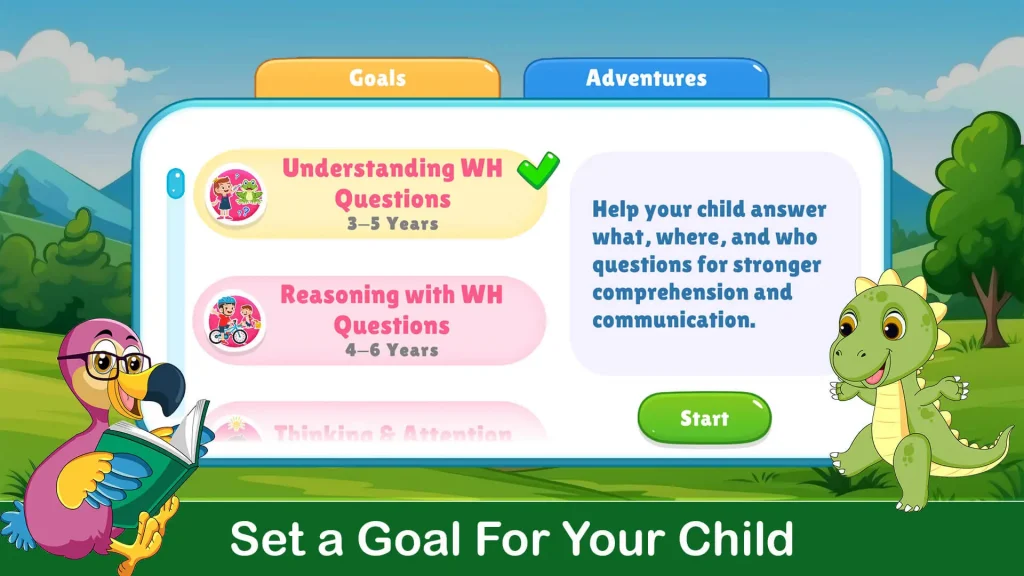
Library Mode
Library Mode offers free exploration and flexibility—perfect for reinforcing specific goals or practicing favorite activities at any time. Instead of following a fixed sequence, children (and parents) can browse across categories like animals, emotions, everyday objects, or WH questions to revisit what they’ve learned or focus on areas that need extra attention.
This mode encourages independent practice, making learning feel like play rather than therapy. Parents can use it to support home speech practice, select targeted exercises for autism learning routines, or simply give their child the freedom to explore topics that spark curiosity.
Library Mode is especially valuable for parents and therapists who prefer adaptable sessions. Whether you want to strengthen pronunciation, build vocabulary, or revisit emotional learning games, Library Mode makes it simple to personalize each experience. It’s one of the features that makes BASICS stand out as a speech therapy app for kids and an autism app for kids designed for real progress at home.
What Makes BASICS App Different From Other Speech Therapy Apps
When it comes to speech and language apps, most tools rely heavily on repetition or flash-based drills. While repetition helps with articulation, it can quickly become routine and disengaging—especially for children who learn best through play.
BASICS App takes a different approach, combining structured speech goals with emotional learning, interactive visuals, and therapist-guided design. The result is an experience that feels like play but delivers meaningful, measurable language progress.
Comparison: BASICS vs Typical Speech Therapy Apps
| Feature | Typical Speech Therapy Apps | BASICS App |
|---|---|---|
| Learning Style | Primarily repetitive word drills and static flashcards | Interactive, story-based learning that engages speech, emotion, and cognition |
| Therapist Involvement | Often designed for general practice, limited therapist input | Developed by speech and occupational therapists with real developmental sequencing |
| Speech Goals | Focus on articulation or single-word repetition | Builds from sounds → words → sentences → social communication through structured levels |
| Vocabulary Context | Abstract or isolated word lists | Real-world vocabulary—animals, foods, routines, emotions, and people children actually see daily |
| Visual Modeling | Minimal or static imagery | Dynamic video modeling and context-based scenes showing how words are used in real life |
| Emotional Learning | Usually missing; focuses only on verbal output | Integrates emotion recognition, empathy, and turn-taking for holistic communication growth |
| Adaptability for Non-Verbal Kids | Limited support for visual learners or AAC transition | Designed for both verbal and minimally verbal children using visual cues, sound imitation, and gesture prompts |
| Parent Involvement | Parents act mainly as observers | Parents can track progress, choose goals, and reinforce skills through Goal Mode and Library Mode |
| Engagement Factor | Repetitive and task-like | Playful, gamified design keeps children motivated and reduces resistance to practice |
Why This Matters for Every Child
Unlike many autism apps for kids, BASICS App combines speech, play, and emotional learning seamlessly. Each activity supports both verbal and non-verbal communication—encouraging children to point, tap, imitate, and eventually speak. For minimally verbal learners, visual modeling and real-life vocabulary bridge the gap between recognition and expression.
For verbal children, story-based sentence practice and social-emotional scenes expand their ability to communicate feelings, thoughts, and ideas confidently.
By uniting therapy structure with joyful play, BASICS App helps every child—no matter their starting point—build communication skills that truly connect to the world around them.
Inside the Activities – What Children Actually Do
The BASICS App turns speech and learning practice into an engaging, play-based experience that feels like fun, not therapy. Every activity is carefully designed by speech and occupational therapists to strengthen early learning, attention, and communication through audio, visual, and interactive feedback. Here’s what your child actually experiences inside the app:
Matching and Memory Games – Building Attention and Recall
In the early levels, children play matching and memory-based activities that sharpen focus, visual attention, and short-term memory. They tap to find pairs, remember object positions, or match sounds with pictures.
- Audio feedback reinforces correct answers with encouraging sounds and voice prompts.
- Visual cues (color flashes, icons, or movement) keep children engaged and alert.
- Interactive feedback lets kids instantly retry or celebrate correct choices—teaching persistence and accuracy.
These foundational games make learning attention and recall skills fun and rewarding.
Video Modeling – Encouraging Speech Imitation
In the Word Wonders section, BASICS App uses video modeling—a research-backed technique where children watch and imitate real people or animated models naming objects, actions, or emotions.
- Each short clip features clear articulation, expressive gestures, and simple language.
- Audio modeling helps children hear how words are pronounced.
- Visual modeling supports lip-reading, expression, and imitation.
- Interactive feedback invites them to repeat or choose the correct word after watching.
This combination of hearing, seeing, and responding helps children practice speech naturally—perfect for toddlers and children in speech therapy programs.
WH Questions & Sentence Building – Strengthening Comprehension
Through the Inquiry Island and Sentence Symphony levels, children practice answering what, where, who, when, and why questions and forming simple sentences.
- Activities like “What is the boy doing?” or “Where is the ball?” help build comprehension and expressive language.
- Audio prompts guide children to listen carefully before responding.
- Visual scenes make understanding easier, showing real-world contexts.
- Interactive choices encourage independent thinking and confident speaking.
This structure supports both receptive (understanding) and expressive (speaking) language growth—key goals in any speech therapy app.
Emotions Explorer – Building Emotional Awareness
BASICS App helps children recognize and name feelings like happy, sad, angry, or scared through Emotions Explorer.
- Children tap faces or scenes to match emotions with expressions.
- Audio cues describe each feeling clearly (“This girl looks happy!”).
- Visual examples show real emotions on diverse faces.
- Interactive feedback celebrates correct answers with positive reinforcement.
This emotional learning strengthens empathy, social understanding, and self-regulation—skills essential for both communication and relationships.
Math Magic – Developing Pre-Academic Readiness
In the Math Magic level, children explore early number, size, and quantity concepts through playful exercises like counting apples, comparing big and small, or adding with objects.
- Audio guidance encourages counting aloud and understanding quantity.
- Visual aids make math concrete with colorful objects.
- Interactive tasks let kids tap, drag, and combine items to see immediate results.
This interactive design makes foundational math feel like exploration rather than instruction—ideal for families seeking an early learning app for toddlers that blends fun and skill-building.
Each activity in the BASICS App blends audio prompts, visual cues, and interactive engagement to make learning multisensory and effective. Whether your child is improving speech clarity, emotional understanding, or academic readiness, every tap builds confidence, focus, and joy in learning.
How BASICS Tracks Progress and Keeps Kids Motivated
Children learn best when their progress feels visible and rewarding — and that’s exactly how the BASICS App keeps motivation high. Every tap, match, or correctly answered question turns into a small win that children can see and celebrate, making learning both structured and joyful.
1. Visual Progress Tracking That Builds Confidence
BASICS App uses simple, colorful progress indicators that help children understand how far they’ve come. Each time your child completes an activity, the app highlights their improvement with stars, bars, and cheerful animations. These visual cues create a sense of achievement that fuels confidence and encourages continued engagement. For younger children, this instant feedback helps connect effort with accomplishment — a key element in building intrinsic motivation.
2. Badges and Rewards for Positive Reinforcement
To make practice even more exciting, BASICS App includes a badge and reward system designed around positive reinforcement. As children complete learning sets or achieve new milestones, they unlock digital badges celebrating skills like “Great Listener,” “Color Champ,” or “Sentence Star.” These small moments of recognition keep practice playful and meaningful, motivating kids to return to their goals without external pressure.
Rewards also help establish consistency — every completed level or repeated success reinforces the habit of learning, which is essential for speech and language progress.
3. Skill Reports and Activity Summaries for Parents
Parents can easily monitor growth through in-app skill reports and activity summaries. Each goal shows detailed insights into what your child practiced, where they’re improving, and which areas might need more support. The reports are organized by categories — such as matching, speech sounds, emotions, or comprehension — helping parents and therapists make informed choices about what to focus on next.
By combining clear visual feedback for children and transparent progress data for parents, BASICS creates a shared learning experience that’s encouraging for both sides.
4. Goal Completion: The Key to Consistent Practice
Every completed goal in BASICS App represents more than a finished activity — it’s a confidence milestone. As children see their progress bars fill and goals marked “complete,” they feel proud of their effort, not just the outcome. This structured goal system makes speech practice purposeful and consistent, reducing resistance and transforming repetition into routine.
Through positive reinforcement, visual milestones, and clear feedback, BASICS ensures that progress never goes unnoticed — helping every child stay motivated, engaged, and proud of their learning journey.
The Role of Parents – Supporting Your Child’s Learning Journey
Parents play the most powerful role in helping children grow through everyday moments of connection. Even short, structured play sessions can create lasting change when combined with meaningful interaction. The BASICS App is designed to make this easy—helping parents turn ordinary routines into learning opportunities that build speech, language, and confidence.
1. Make Daily Practice a Habit
Set aside 10–15 minutes each day for focused play using the BASICS App. Choose one goal at a time—such as naming animals, matching emotions, or identifying colors. Consistency is more important than duration; regular repetition helps your child remember and use new words naturally. Many families find that evening wind-down or post-school routines are perfect for short, distraction-free sessions.
2. Connect App Learning With Real Life
What children practice on the screen becomes stronger when reinforced in daily activities.
- Naming toys: “Let’s find your red car—just like in the app!”
- Describing food: “This banana is yellow and soft.”
- Talking about emotions: “You look happy—like the smiling face we tapped today!”
These simple reinforcements turn passive screen time into active learning, helping children with speech delay or autism connect words to real-world experiences. Parents can also use these moments to model clear pronunciation and simple sentences, supporting speech therapy at home in a relaxed, playful way.
3. Track Growth With the Parent Dashboard
Inside BASICS App, the Parent Dashboard provides an easy-to-read progress overview. It shows which goals your child has practiced, completion streaks, and how performance improves over time. Reviewing progress together motivates children and builds their sense of achievement—especially for kids using the autism app for kids version of BASICS that includes adaptive feedback and visual rewards.
4. Building Language Every Day
By combining short, engaging BASICS sessions with real-life talk, you turn daily experiences into lessons in observation, expression, and confidence. The app acts as a language learning app guide, but your participation transforms it into a personalized speech journey—one where every smile, word, and moment of attention helps your child move closer to clear, confident communication.
Therapist Insights – Why BASICS App Works in Real Therapy Settings
Speech and occupational therapists across India and abroad are increasingly integrating the BASICS App into both teletherapy and hybrid therapy sessions — and for good reason. Designed by professionals, the app combines structure, interactivity, and progress tracking to make every session more effective and engaging for children.
Therapists use BASICS during online speech therapy sessions to demonstrate articulation models, practice vocabulary, or work through WH question and social communication goals in real time. In hybrid models, BASICS bridges the gap between clinic and home practice — parents continue the same activities introduced in therapy, ensuring consistency and measurable progress.
“Therapists find BASICS useful for tracking goals and keeping kids engaged. The built-in visuals and voice prompts save session time, while the child-friendly interface encourages participation without pressure.”
Beyond its use as a speech therapy app, BASICS is also widely recognized as an autism app that supports both communication and emotional regulation. Its therapist-designed levels — from Foundation Forest to Conversation Circles — help children develop language, attention, and social skills in small, repeatable steps.
In teletherapy for kids, BASICS serves as a virtual extension of the therapist’s toolkit. Through screen sharing or guided practice, professionals can monitor responses, note progress, and adjust goals within the app’s framework. This seamless integration makes therapy sessions more structured, interactive, and personalized — even from a distance.
By combining professional expertise with digital innovation, BASICS empowers therapists to deliver effective, motivating sessions while helping children achieve real, lasting growth in speech and communication.
How to Get Started With BASICS
Getting started with the BASICS App is simple, quick, and completely stress-free — designed so parents can begin within minutes, even without any prior therapy or teaching experience.
Step 1: Download the App
Visit the Google Play Store or Apple App Store, search for BASICS: Speech and Learning App, and install it on your device. The app runs smoothly on both phones and tablets, making it easy to use anytime, anywhere.
Step 2: Create Your Child’s Profile
Once you open BASICS, you’ll be guided to create a child profile. Just enter your child’s name and age, and the app automatically tailors activities to the right developmental level — from toddlers just starting to speak to early learners ready for sentences and pre-math concepts.
Step 3: Select the Age and Learning Goals
Choose your child’s age range and pick the first goal-based module that matches their needs — whether it’s early learning, speech sounds, vocabulary, or emotional skills. Every activity is therapist-designed and play-based, ensuring your child learns while having fun.
Step 4: Begin Goal-Based Learning
No setup, no calibration, no tutorials to figure out — just tap “Start,” and your child can immediately explore interactive games, videos, and picture-based lessons. BASICS adapts to their responses, gently guiding them toward progress at their own pace.
Every screen is intuitive and engaging, so even young children can navigate independently. Parents can track learning milestones, celebrate small wins, and switch between Goal Mode (structured learning) and Library Mode (free exploration) anytime.
About Wellness Hub
Wellness Hub is a trusted digital platform that empowers parents, caregivers, and professionals with science-backed tools for childhood development. From online speech therapy to home therapy resources, we offer a holistic ecosystem for children facing speech delays, autism, ADHD, and other developmental challenges.
Rooted in evidence-based practices and delivered by certified experts, Wellness Hub bridges the gap between accessibility and quality care. Whether you need at-home speech strategies, developmental checklists, or interactive mobile apps like BASICS App, we make early intervention affordable and family-friendly.
Start your journey today with expert guidance tailored to your child’s unique communication and learning needs—anytime, anywhere.
Frequently Asked Questions
1. Is BASICS a free speech therapy app for kids?
BASICS offers free access to select activities that focus on speech, vocabulary, and emotional understanding. Parents can explore foundational lessons and then unlock more levels designed by therapists for structured learning at home.
2. Can I use BASICS without a therapist?
Yes. BASICS is designed for both independent home use and therapist-guided sessions. Its intuitive activities, visuals, and voice prompts make it easy for parents to help children practice communication, emotions, and social skills without formal training.
3. How does BASICS support children with autism?
BASICS supports children on the autism spectrum by combining structured visuals, repetition, and play-based interactions. Activities such as Emotions Explorer and Conversation Circles promote joint attention, eye contact, and emotional regulation in a calm, predictable environment.
4. What age group is BASICS ideal for?
The BASICS App is designed for children aged 2 to 8 years, covering the key developmental stages of speech, language, social, emotional, and early cognitive growth. Each level adapts to your child’s learning pace.
5. How long should my child use BASICS daily?
Consistency matters more than duration. Using BASICS for 10–15 minutes a day can help children steadily improve focus, emotional awareness, and speech clarity. Short, regular sessions build stronger habits than long, infrequent use.
6. Is BASICS available offline or on multiple devices?
Yes. Once downloaded, many BASICS activities work offline—perfect for travel or limited internet access. Parents can also sync progress across multiple devices, allowing consistent learning at home or during therapy.
7. How does BASICS teach emotional regulation to young children?
BASICS uses visual emotion cards, story-based play, and positive reinforcement to help children identify feelings like happy, sad, angry, or calm. Through guided interactions, kids learn to recognize emotions in themselves and others, building early self-regulation.
8. Can BASICS improve social interaction and empathy?
Yes. Activities such as Conversation Circles and Social Stories encourage children to take turns, listen, and respond to others’ feelings. Over time, this strengthens empathy, cooperation, and real-world communication skills.
9. What makes BASICS different from other emotional learning apps?
Unlike generic learning apps, BASICS is therapist-designed and integrates speech, language, and emotional learning in one structured path. It connects digital play with real-life understanding, helping children express themselves with confidence and empathy.
10. How can parents track progress in BASICS?
Parents can view goal completion, emotional vocabulary milestones, and activity streaks inside the app’s Goal Mode dashboard. These insights show gradual progress and help guide the next learning steps for their child.
Book your Free Consultation Today
Parent/Caregiver Info:
Client’s Details:
* Error Message
